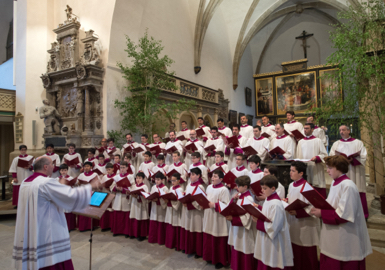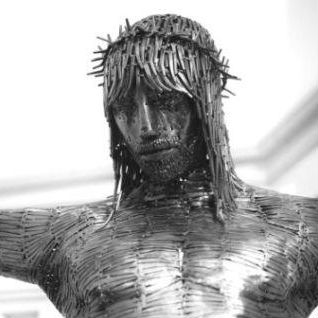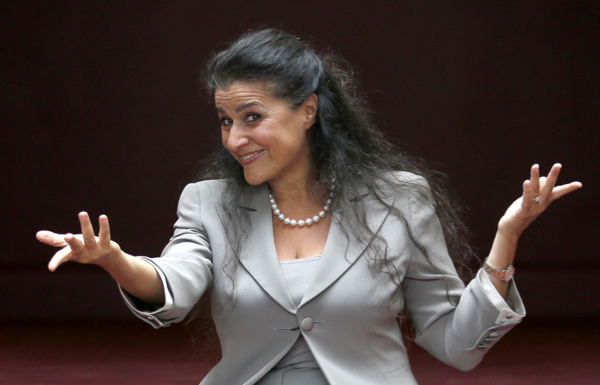Cecilia Bartoli, the Italian mezzo-soprano opera singer, has become the first woman to perform with the choir of the Sistine Chapel in Rome.
On Friday night she joined the 20 men and 30 boys of the choir to sing Beata viscera Mariae Virginis, by the medieval monk Pérotin, who worked in Nôtre Dame Cathedral in the 12th century. The work is one of the pieces on the choir's third CD in collaboration with Deutsche Grammophon.
Veni Domine: Advent and Christmas at the Sistine Chapel, is a collection of works from the Vatican archives about Advent and Christmas.
Mark Spyropoulos, a baritone, who is the first English member of the Cappella Musicale Pontificia "Sistina" told The Tablet: "Some of them have not been heard for 400 years. They have been lying dormant, collecting dust, in the Vatican archives."
The works were found by Massimo Palombella, director of music, who has access to the complete music archives of the Vatican and has been hunting down music written specifically for the choir to be sung in the Sistine Chapel over the centuries.
Spyropoulos said: "The acoustic of the chapel is essential to how the works were conceived. It is an intimate space with a warm, resonant acoustic that has to be handled with care. The sound does not need to be pushed at all.
“It is like skimming a stone across a frozen pond. You touch it and it goes.
"A cacophony of resonance is a mess in the Sistine Chapel. We sing sotto voce. Then the music glows.”
He added: "Cecilia is one of the prime artists of her generation. Her specialism is early music. She is a musicologist herself. She has sung a lot of works by composers like Vivaldi that have never been heard before. She was an obvious choice for this. It is a great honour for us to be working with an artist of that calibre.”
Before Mark joined the choir, while he was still studying, he worked at the Royal Opera House in Covent Garden, presenting flowers on the stage to performers. “For a young singer, training, it was the best job in the world. I would stand in the wings at Covent Garden and hear the greatest singers, night after night. I presented Cecilia with bouquets many, many times."
The Sistine Choir event with Bartoli took place just days before the feast day of St Cecilia, patron saint of musicians, which is tomorrow, 22 November.
Spyropoulos said: "I think we need more women singing in choirs. I am a huge supporter of that. Generally speaking, I would like to encourage as many women and girls as possible to sing choral music.”
 Bartoli herself said in an interview with Corriere della Sera “Being the first woman to sing with the choir, and to record in the Sistine Chapel, is an immense privilege, I am at a loss for words. I am in seventh heaven, may I say that?
Bartoli herself said in an interview with Corriere della Sera “Being the first woman to sing with the choir, and to record in the Sistine Chapel, is an immense privilege, I am at a loss for words. I am in seventh heaven, may I say that?
"Rome, my city, the Sistine Chapel, it is wonderful incredible. I have no words for this extraordinary place. And to be able to make music in the Sistine Chapel with Maestro Palombella, with the Sistine Chapel Choir, with the boys and the men, Pérotin’s music – it is like a dream.”
At a recent press conference for the presentation of the CD, Massimo Palombella explained that the repertoire on the CD draws from Renaissance manuscripts from the Sistine Chapel archive collection held in the Vatican Apostolic Library.
"The ancient musical archives of the Vatican Apostolic Library, among the largest and most important in the world, from the second half of the eighteenth century have been indispensable documents of reference for musical historiography and for musicological research. The treasures of polyphony of the humanistic, Renaissance and Baroque period, conserved especially in the Sistine Chapel and Chapel Julia collections, have been and continue to be the object of study by researchers from all over the world, especially after their transfer from the cantories of their respective original institutions to the Vatican Apostolic Library (in the 1930s to 1940s for the materials of the Chapel Julia, a few decades earlier for those of the Sistine Chapel)."
He also explained that the exchange between the compositions of the fifteenth and sixteenth centuries, and the consideration of the role that the Pontifical Sistine Choir Chapel has held historically in this aesthetic change, necessitates reflection on the liturgical reform of the Council of Trent and how much this Council and its application required of music destined for the Liturgy.
"In summary, attention to the text and the request to modify what was 'lascivious and impure' originated from the Conciliar demand to restore music destined for the liturgy to its primary function, that of giving form in sound to a text, through this process performing an 'exegesis' of the latter. This is exactly what Gregorian chant did. Indeed, through its 'grammar' (modes, tones), in that precise moment it 'explained' the Revelation, it performed an 'exegesis' of the Word of God. The same process was fulfilled by Renaissance polyphony, with another aesthetic compared to that of Gregorian chant. Through its grammar, more evolved by comparison to monody, it again gave shape in sound to a text explaining, in its own way, the Revelation."
He said the music present on the new CD was historically composed for the Papal Celebrations and continues today, even after the liturgical reform of Vatican Council II, to be part of it, with its careful attention to precise “celebratory pertinence”.
Mgr. Georg Gänswein, prefect of the Papal Household, said: "For the third consecutive year I have the honour and the pleasure of presenting a CD recorded by the Pontifical Sistine Chapel Choir, in its natural home, the Sistine Chapel, released under the prestigious recording label Deutsche Grammophon."
He described it as a "milestone" and said the CD was "particularly rich not only in terms of the quality of production but also for the choice of music, which introduces us to the heart of the Christian mystery: the incarnation of the Word, the Nativity of the Lord."
He added: "A recording of this type is, indeed, an announcement of the Good News implemented through art, specifically music, so that the contact of many people of different cultures and origins with a specific musical repertoire and with the search for God that permeates it, may inspire a growth in the spiritual path or even a first interest in He Who is the origin of all beauty."
(Pics: Top: Cecilia Bartoli, and the Vatican-based Sistine Chapel Choir led by its director Massimo Palombella. Pic credits: PA)



 Loading ...
Loading ...